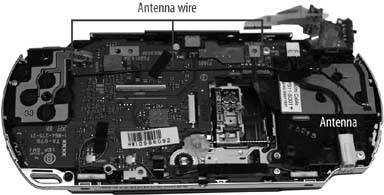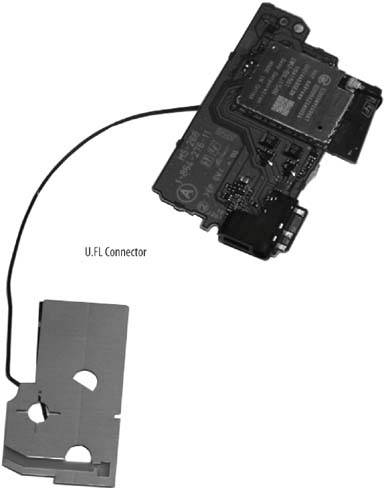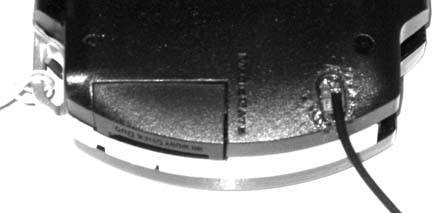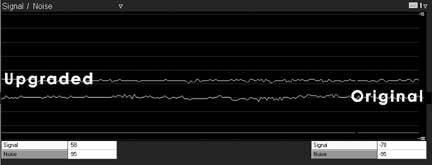Hack17.Add an External Wireless Antenna
Hack 17. Add an External Wireless Antenna
This modification will not only increase the range and strength of your wireless signal for better online gaming, but it also will earn you major geek points when you pull out a foot-high, omnidirectional antenna at the next PSP-a-thon. The PSP comes with built-in wireless networking support that allows you to connect to other players for true multiplayer action [Hack #5]. In addition to this, your PSP can also be used to surf the Net, serve up web pages, and more. For all this, you need to be sure your wireless connection is strong and solid. Unfortunately, the internal wireless antenna is limited by both power and size. As a result, your connection weakens rather quickly the further you get from the access point. To help overcome this weakness, I have worked out the details and steps you need in order to upgrade the PSP wireless abilities by adding in an external antenna that not only gives you extra range and strength, but also turns your PSP into a device that won't be overlooked. 2.7.1. Finding a ReplacementThe first step in this process is to find a viable replacement antenna that will make your signal stronger, without tying you to a large and weighty antenna that you need a suitcase to carry. This will require you to deal with various acronyms and cryptic terms, since the FCC has made it annoying to upgrade wireless antennas on any particular device. First, on the network card, you will find a U.FL connector. Fortunately, these are fairly standard and you can easily find an antenna with a matching U.FL connector that will just plug into the PSP WNIC. However, this is not the best method, even if it is the one I use for this particular hack. The reason I mention this is that once the hack is in place, you will not be able to easily remove it. That said, if you purchase and install a single component wireless antenna-pigtail-U.FL connector, you will be forced to lug the entire contraption around wherever you take the PSP. Therefore, I recommend you first purchase a U.FL to N Male pigtail, then purchase an omnidirectional antenna with an attached N Female connector. This two-part solution not only allows greater portability, but if you desire a satellite dish antenna upgrade (35+ mile range) at a future date, it is as easy as disconnecting the omni-direction and screwing the N Female pigtail on the dish. In general, a U.FL to N Male pigtail should run about $10 USD and an N Female omni-directional antenna should run $15+ USD, depending on size. For this replacement, I used a simple pigtail with 5dBi combination. I purchased this antenna for about $20 USD with shipping off of eBay (http://www.ebay.com), and it even came with a stand for easy mounting. 2.7.2. Out with the OldNext, you need to remove the original antenna from the PSP. This presents a bit of a problem, because the antenna connector is buried at the bottom of the device and requires you to completely disassemble the device [Hack #8]. When taking the PSP apart, you will see the antenna and its associated wiring once you remove the LCD tray. As Figure 2-46 illustrates, the antenna is located on the right side of the PSP, under the controller pad. From the antenna, you can see a black wire that trails across the entire width of the PSP and disappears beneath the left controller pad. If you lift the left controller, you can see that the wire actually drops down into the PSP case and connects to the network card buried below the main circuit board. Once you have the PSP completely disassembled, you will need to remove the network card and attached antenna wire from the case. Figure 2-47 illustrates what this component looks like. Two items are of interest at this point. First, the wire used to connect the WNIC (Wireless Network Interface Card) with the antenna is not of a high quality. As a result, the signal will experience some loss when passing through the wire and the electronics of the PSP. Second, the actual antenna is no more than a couple of inches long and is located in the brown flat plastic piece found under the right-side controller. These two attributes of the antenna provide a good indicator as to its limits. I am confused as to why the PSP designers would put the antenna in such a location, because the water in the human body causes signal attenuation. Since your hand basically wraps around the antenna when playing the PSP, your signal suffers about a 10db loss. Figure 2-46. The PSP's antenna wire Figure 2-47. NIC with antenna Once you get the network card out of the PSP, you will need to remove the original antenna from the U.FL socket. This is accomplished by firmly levering the original antenna U.FL connector out of the U.FL socket. Be sure to use perpendicular force, because the connector is quite fragile. 2.7.3. In with the NewAt this point, you are ready to start the antenna upgrade. The first thing you will need to do is to create a hole in the PSP case through which you will pass the new pigtail. The location of this hole is important, because the PSP is such a tightly designed device that there is really only one option for this hole. In addition, the PSP case itself will support the new U.FL connector by applying counterpressure against the connector to keep it in place. Figure 2-48 illustrates where you should cut, melt, or drill the hole. For my trial run of this hack, I chose to melt a hole in the PSP's case using a soldering iron. While this worked, the result was a little messy. I recommend using a drill to make a clean, round, and more professional-looking hole. Figure 2-48. The new hole in the PSP Once the case is updated, take the U.FL pigtail upgrade and slip the U.FL connector through the hole, and seat it firmly into the circuit board's U.FL socket. Then carefully reinsert the network card back into the PSP case and be sure the new pigtail and U.FL connector fits. If it does, you then need to put the entire PSP back together again [Hack #9]. Figure 2-49 provides you with a shot of the completed hack. Figure 2-49. The final product 2.7.4. Testing the ModModifications are great, but they are only of value if they actually enhance a certain feature of a product. In this case, you want to enhance the wireless signal strength, which means you need to compare the original antenna with the upgrade to see if there is really a benefit. For this test, I used a program called AirMagnet (http://www.airmagnet.com/) that, among other things, has a nice signal strength graphic output. Figure 2-50 illustrates very clearly the difference between the two signals. Table 2-1 lists the signal strength versus noise ratio (SNR). What is most interesting about these results is that the new antenna obtained a much greater increase (13db) than I expected from a 5db antenna. From this, I can only assume that moving the antenna outside the PSP body and using a higher-grade wire helped to reduce the signal loss. When combined with the greater gain of the antenna, the increase is much greater than can be credited to the new hardware. Figure 2-50. AirMagnet
2.7.5. Hacking the HackWith this hack, it would be possible in theory to play PSP to PSP with someone miles away with the right antenna. You could also add an amplifier to your setup and have the FCC come hollering. The sky is really the limit, if you start with a pigtail attachment. Keeping a common N Male connector on the end means you will have many options when it comes to selecting the antenna. Seth Fogie |
EAN: 2147483647
Pages: 108